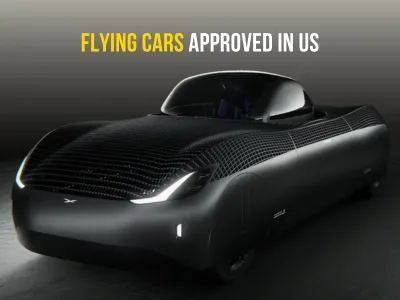Now jump ahead to today, and you’ll see that we’re getting closer to achieving this venerable objective. In gratitude for technical advancements, the flying car is a reality today. Companies around the globe are competing to be the first to commercialize a safe and efficient flying car, sparking renewed interest in this fascinating concept.
As we stand at the intersection of creativity and innovation, a new era in transportation is just around the corner. We’ll go into this topic and look at the history of flying cars, how technology is progressing in this field, and any future repercussions that could arise from this fascinating frontier. Get ready for takeoff; buckle up; we’re going to travel to the world of flying vehicles.
The Dream Of Flying Cars
The dream of flying cars is as old as the automobile itself. As soon as we mastered the art of travelling on four wheels, we began to imagine what it would be like to take our vehicles to the skies. It’s an idea that has been a constant source of fascination, symbolizing ultimate freedom and technological prowess. The vision of flying cars represents more than just a new mode of transportation; it stands for the very essence of innovation and the human spirit’s boundless capacity for creativity and advancement.
This dream has been further cemented by popular culture’s powerful grip. From the animated series ‘The Jetsons’, where George Jetson commutes in his compact flying car, to the spectacular flying DeLorean in ‘Back to the Future’, these depictions have shaped our collective imagination of the future. Even recent hits like the Marvel Cinematic Universe’s ‘Avengers’ series demonstrate the persistent allure of flying cars with Tony Stark’s futuristic rides.
These references have not only entertained us but also influenced our perceptions and expectations. They have made us yearn for a future where gridlock is a thing of the past, replaced by a 3D network of sky lanes. They have inspired scientists, engineers, and entrepreneurs to work towards turning this dream into reality.
Progress In Flying Car Technology
Over time, the advancement of flying car technology has been nothing short of amazing. Thanks to advances in battery energy density, materials chemistry, and computer modelling, we can now make the idea of flying cars from science fiction a reality.
Leading the charge are several innovative companies. For instance, Xpeng, a Chinese electric vehicle manufacturer, recently made headlines when their X2 flying car prototype successfully completed its first public test flight. This demonstrates how rapidly the technology is advancing and the earnest strides being made toward commercial viability. Current prototypes and models, like the Xpeng X2, are impressive feats of engineering, but they also represent the first steps in a much larger journey.
The Challenges Of Flying Cars
Flying cars, while exciting, also present significant technical challenges. Safety is paramount, as these vehicles will need to be nearly foolproof to prevent catastrophic accidents. They’ll need to be able to navigate complicated air traffic situations, deal with weather conditions, and land safely in emergencies. Fuel efficiency is another concern. Noise is also a significant factor; nobody wants the constant drone of cars overhead to become a new form of pollution.
Regulatory and infrastructural hurdles are also considerable. Air traffic control systems would need a massive overhaul to handle potentially thousands of personal aircraft in the skies above a city. It would be necessary to establish laws and regulations that would limit the places and times that these vehicles might fly, as well as their speed, altitude, and other capabilities. Additionally, it would be necessary to build the infrastructure, including takeoff and landing zones and repair facilities, needed to support flying cars.
There are also societal implications to consider. For one, the affordability of flying cars could be a major issue. It’s likely that the initial models will be expensive, potentially widening the gap between the rich and the poor. There could also be significant effects on cities and urban living. While flying cars could help reduce road traffic, they could also lead to increased congestion in the skies. Additionally, they could potentially change the landscape of cities, with more skyports and less need for roads and parking spaces.
The Future Of Flying Cars
A. Predictions based on current trends and advancements:
B. Potential timeline for when flying cars might become a reality:
C. The impact on transportation and society:
BMW Flying Car Price In India
As of now, the concept of flying cars is still in its developmental phase, and there’s no specific model from BMW available for purchase. However, to give you an idea, the first government-approved flying car, the Alef Model A, starts at around USD 300,000, which is approximately Rs 2.46 crore.
Xpeng X2 Car Price In India
Xpeng X2 flying car, produced by Chinese electric vehicle maker Xpeng, is expected to be mass-produced by 2024, and the price is expected to be less than $157,000. Given the exchange rate, this would be around Rs. 1.15 crore in Indian currency. Also, the company hasn’t officially launched the flying car in India yet, so this price is purely speculative.
Real Flying Cars
As of 2023, there are several real flying cars that have been developed, and some are even available for sale. A few notable ones include:
1. Klein Vision’s AirCar:
2. PAL-V Liberty:
3. AeroMobil 4.0:
4.Terrafugia Transition:
5. Renault AIR4:
By following these tips and staying adaptive to the platform’s changes, content creators can increase their chances of meeting the new YouTube Partner Program guidelines and achieving success on the platform.
How Many Flying Cars Are There In The world?
It’s challenging to estimate the precise number of flying cars now on the road. But here is what we do know: The market for flying cars was worth $85.48 million in 2022 and $139.47 million in 2023. This predicts a rise in company financing and interest, which would result in an increase in test and prototype cars. However, the majority of these are not yet accessible or often used.
One company, Eve, has agreed on a potential sale of up to 150 flying cars, indicating that the market is gradually moving from the testing and prototype phase to the commercial phase. Still, the widespread availability and use of flying cars are projected to take off around 2024 or 2025.













